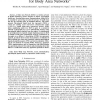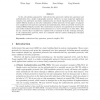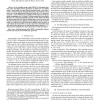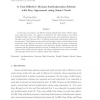141
Voted
TITB
2010
14 years 7 months ago
2010
A Body Area Network (BAN) is a wireless network of health monitoring sensors designed to deliver personalized health-care. Securing inter-sensor communications within BANs is essen...
129
Voted
ISCI
2010
14 years 10 months ago
2010
Key agreement (KA) allows two or more users to negotiate a secret session key among them over an open network. Authenticated key agreement (AKA) is a KA protocol enhanced to preve...
115
Voted
ASIACRYPT
2010
Springer
14 years 10 months ago
2010
Springer
So far, all solutions proposed for authenticated key agreement combine key agreement and authentication into a single cryptographic protocol. However, in many important applicatio...
142
Voted
SCN
2010
Springer
14 years 11 months ago
2010
Springer
We introduce a protocol, that we call Human Key Agreement, that allows pairs of humans to establish a key in a (seemingly hopeless) case where no public-key infrastructure is avail...
109
Voted
TIT
2008
15 years 6 days ago
2008
Abstract--In the bounded-storage model (BSM) for information-theoretic secure encryption and key agreement, one makes use of a random string R whose length t is greater than the as...
114
Voted
CCR
1999
15 years 12 days ago
1999
In this paper a `fair' key generation and certification protocol for Diffie-Hellman keys is proposed, which is intended for use in cases where neither User nor CA are trusted...
121
click to vote
AMC
2005
15 years 19 days ago
2005
In this paper, we propose a cost effective mutual authentication scheme with key agreement using smart cards. Our scheme is motivated by the scheme design in two articles publishe...
115
Voted
SCN
2008
Springer
15 years 20 days ago
2008
Springer
A new identity-based key agreement protocol designed to operate on thenetworklayerispresented. Endpoint addresses, namelyIP and MAC addresses, areusedaspublickeystoauthenticatethe ...
86
Voted
IJNSEC
2006
15 years 22 days ago
2006
Anonymity is a very important security feature in addition to authentication and key agreement features in communication protocols. In this paper, we propose two authentication an...
141
click to vote
IJNSEC
2008
15 years 22 days ago
2008
Most of the current security architectures for grid systems use conventional public key infrastructure (PKI) to authenticate grid members and to secure resource allocation to thes...




